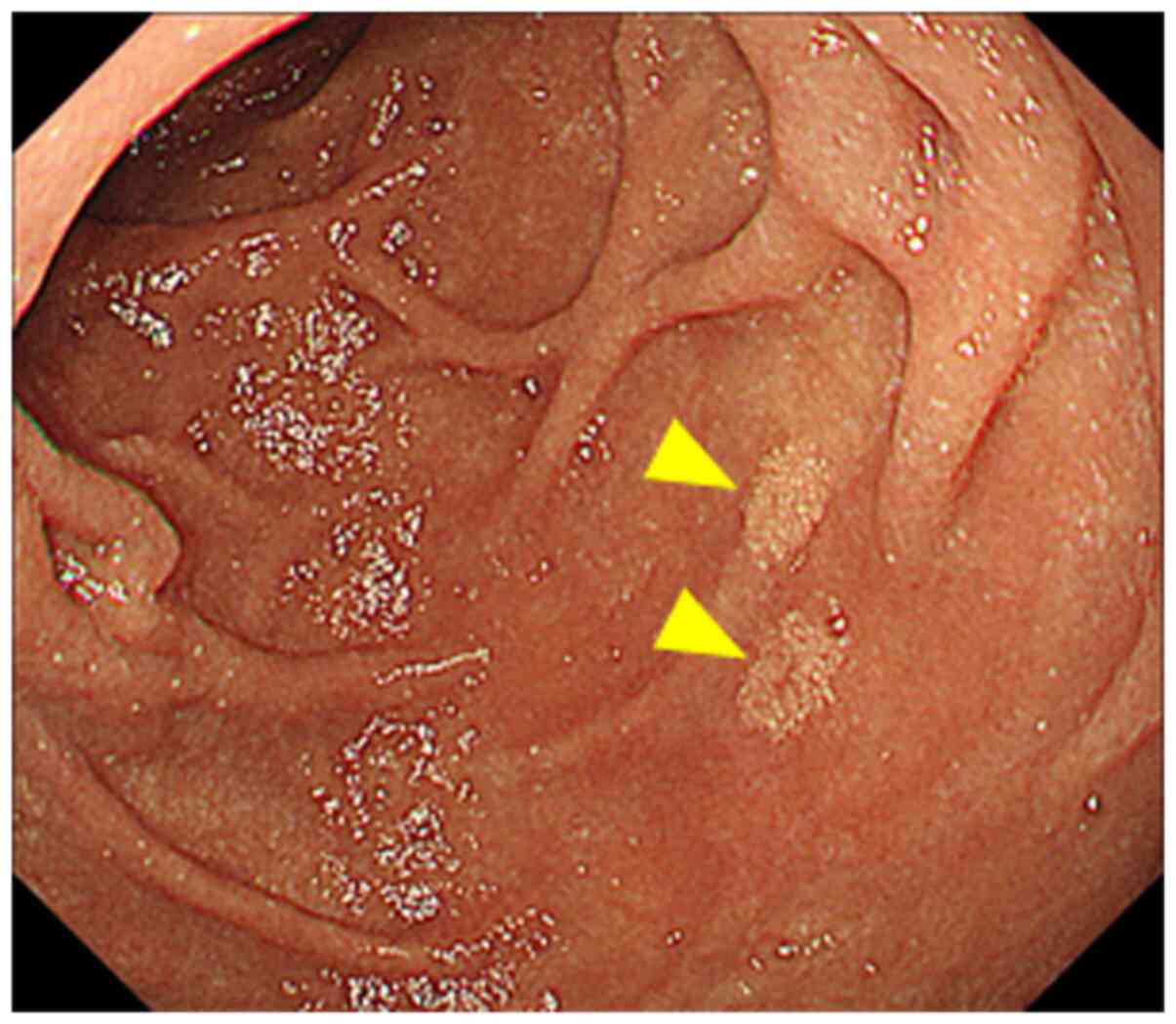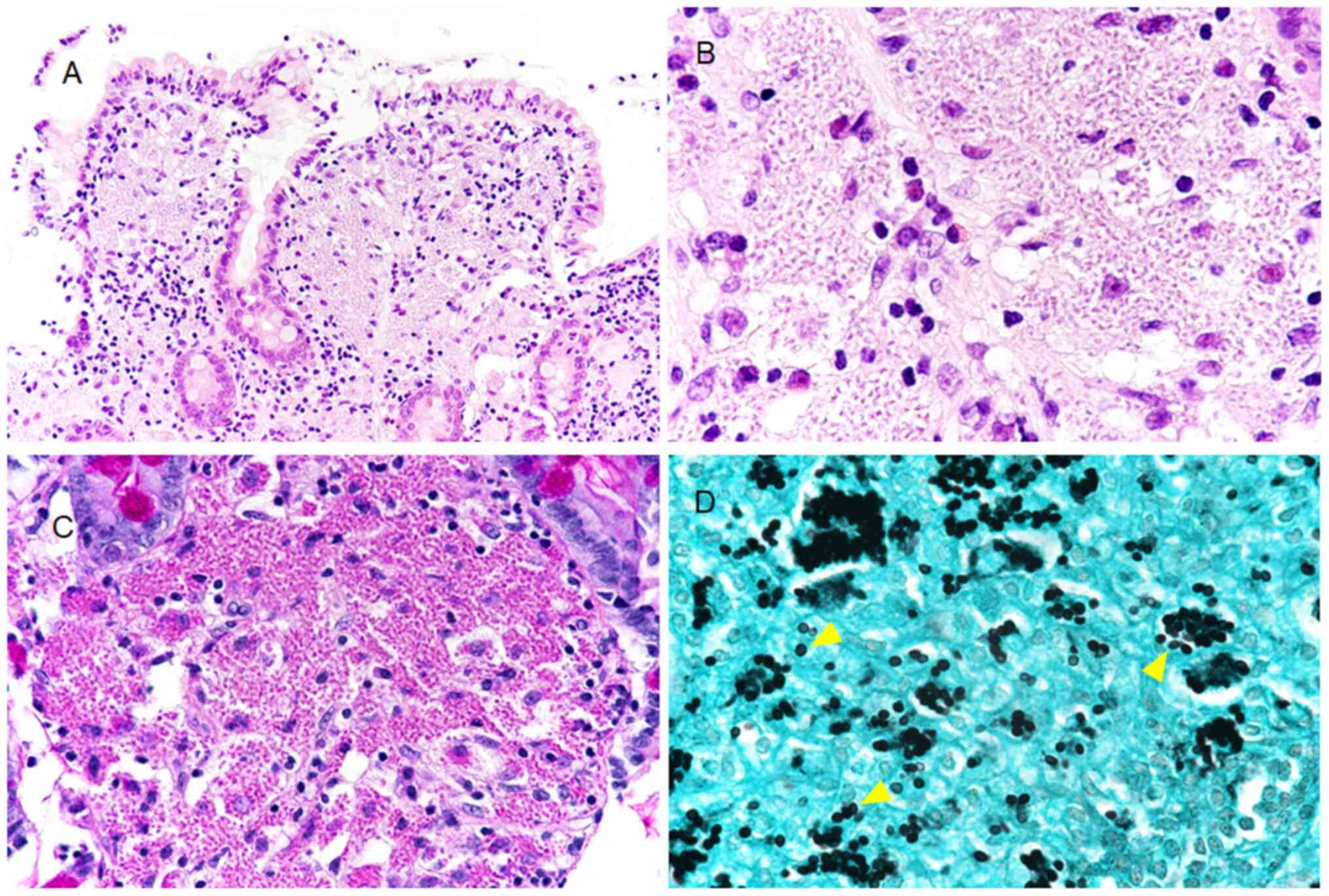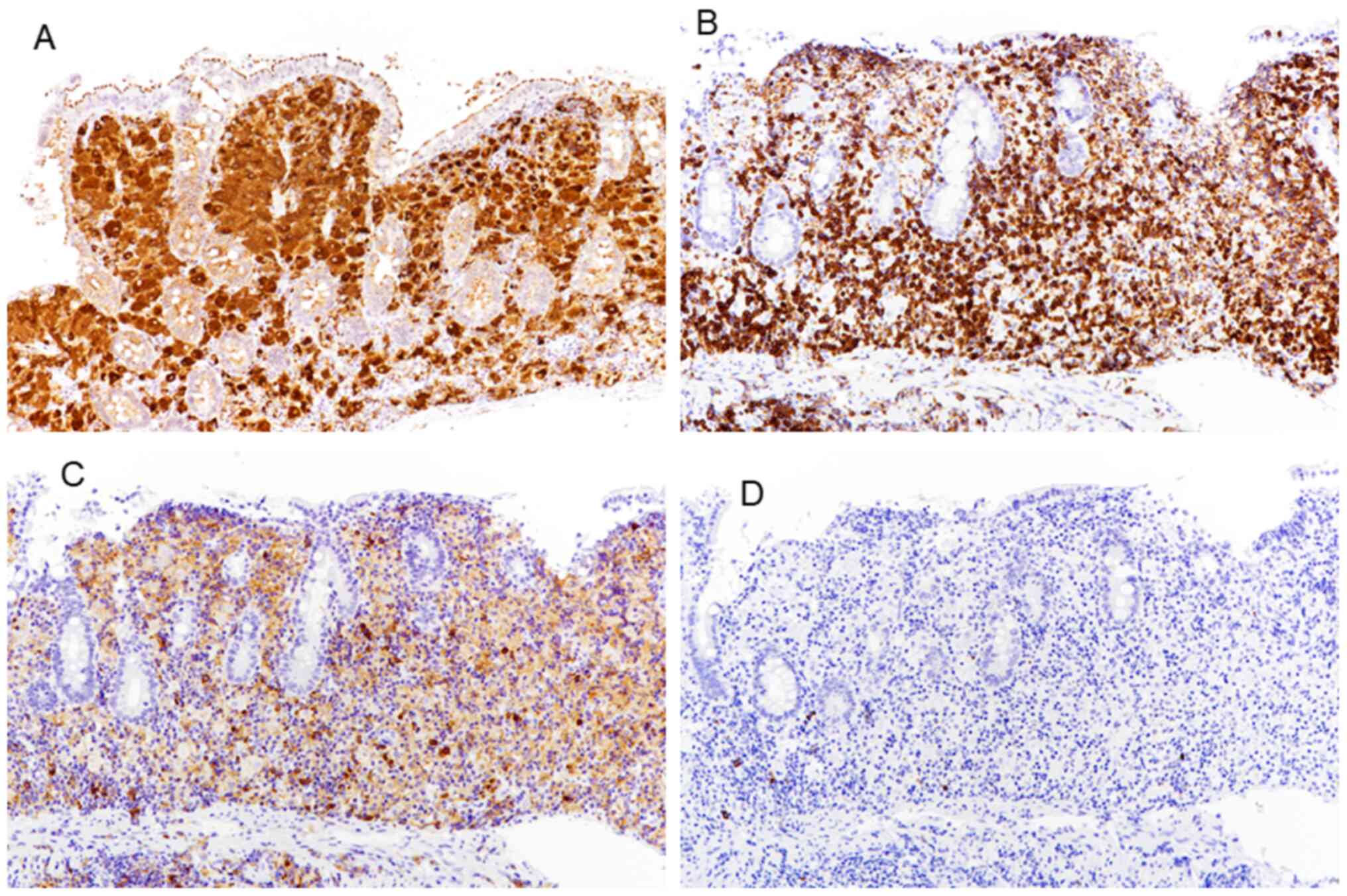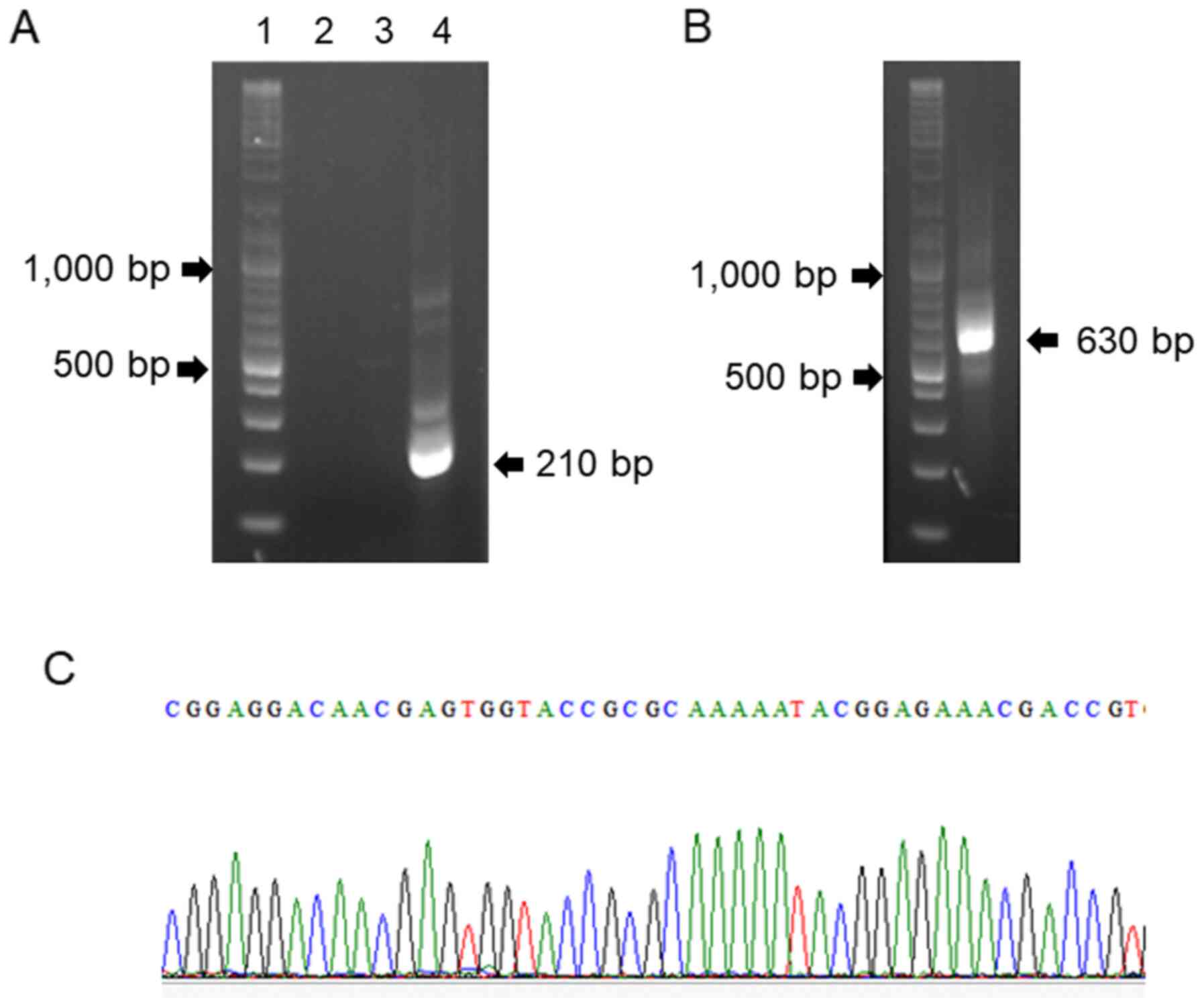|
1
|
Köhler JR, Hube B, Puccia R, Casadevall A
and Perfect JR: Fungi that infect humans. Microbiol Spectr.
5:FUNK-0014–2016. 2017.PubMed/NCBI View Article : Google Scholar
|
|
2
|
Diaz JH: Environmental and
wilderness-related risk factors for Histoplasmosis: More than bates
in caves. Wilderness Environ Med. 29:531–540. 2018.PubMed/NCBI View Article : Google Scholar
|
|
3
|
Bahr NC, Antinori S, Wheat LJ and Sarosi
GA: Histoplasmosis infections worldwide: Thinking outside of the
Ohio River valley. Curr Trop Med Rep. 2:70–80. 2015.PubMed/NCBI View Article : Google Scholar
|
|
4
|
Deepe GS: Histoplasma capsulatum
(Histoplasmosis). In: Mandell, Douglas, and Bennett's Principles
and Practice of infectious diseases. Bennett JE, Dolin R and Blaser
MJ (eds). 8th edition. Elsevier Saunders, Philadelphia, PA,
pp2949-2962, 2014.
|
|
5
|
Hatakeyama S, Okamoto K, Ogura K, Sugita C
and Nagi M: Histoplasmosis among HIV-infected patients in Japan: A
case report and literature review. Jpn J Infect Dis. 72:330–333.
2019.PubMed/NCBI View Article : Google Scholar
|
|
6
|
Kauffman CA: Histoplasmosis: A clinical
and laboratory update. Clin Microbiol Rev. 20:115–132.
2007.PubMed/NCBI View Article : Google Scholar
|
|
7
|
Mukhopadhyay S and Doxtader EE: Visibility
of Histoplasma within histiocytes on hematoxylin and eosin
distinguishes disseminated histoplasmosis from other forms of
pulmonary histoplasmosis. Hum Pathol. 44:2346–2352. 2013.PubMed/NCBI View Article : Google Scholar
|
|
8
|
Zanotti P, Chirico C, Gulletta M,
Ardighieri L, Casari S, Roldan EQ, Izzo I, Pinsi G, Lorenzin G,
Facchetti F, et al: Disseminated histoplasmosis as
AIDS-presentation. Case report and comprehensive review of current
literature. Mediterr J Hematol Infect Dis.
10(e2018040)2018.PubMed/NCBI View Article : Google Scholar
|
|
9
|
Sharma R, Lipi L, Gajendra S, Mohapatra I,
Goel RK, Duggal R, Mishra SR and Gautam D: Gastrointestinal
histoplasmosis: A case series. Int J Surg Pathol. 25:592–598.
2017.PubMed/NCBI View Article : Google Scholar
|
|
10
|
Psarros G and Kauffman CA: Colonic
histoplasmosis: A difficult diagnostic problem. Gastroenterol
Hepatol (NY). 3:461–463. 2007.PubMed/NCBI
|
|
11
|
Azar MM, Loyd JL, Relich RF, Wheat LJ and
Hage CA: Current concepts in the epidemiology, diagnosis, and
management of histoplasmosis syndromes. Semin Respir Crit Care Med.
41:13–30. 2020.PubMed/NCBI View Article : Google Scholar
|
|
12
|
Ohno H, Tanabe K, Umeyama T, Kaneko Y,
Yamagoe S and Miyazaki Y: Application of nested PCR for diagnosis
of histoplasmosis. J Infect Chemother. 19:999–1003. 2013.PubMed/NCBI View Article : Google Scholar
|
|
13
|
Watanabe M, Hotchi M and Nagasaki M: An
autopsy case of disseminated histoplasmosis probably due to
infection from a renal allograft. Acta Pathol Jpn. 38:769–780.
1988.PubMed/NCBI View Article : Google Scholar
|
|
14
|
Walsh TJ, Larone DH, Schell WA and
Mitchell TG: Histoplasma, blastomyces, coccidioides and other
dimorphic fungi causing systemic mycoses. In: Manual of Clinical
Microbiology. Murray PR, Baron EJ, Jorgensen JH, Pfaller MA and
Yolken RH (eds). Vol 2. 8th edition. ASM Press, Washington, DC,
pp1781-1797, 2003.
|
|
15
|
Wojewoda C and Procop GW: Infections with
Yeast and Yeastlike Fungi. In: Pathology of Infectious Diseases.
Procop GW and Pritt BS (eds). Elsevier, Philadelphia, PA,
pp531-572, 2014.
|
|
16
|
Schmitt BH and Pritt BS: Dematiaceous
fungal infections. In: Pathology of Infectious Diseases. Procop GW
and Pritt BS (eds). Elsevier, Philadelphia, PA, pp516-530,
2014.
|
|
17
|
Headley SA, Pretto-Giordano LG, Di Santis
GW, Gomes LA, Macagnan R, da Nobrega DF, Leite KM, de Alcantara BK,
Itano EN, Alfieri AA, et al: Paracoccidioides
brasiliensis-associated dermatitis and lymphadenitis in a dog.
Mycopathologia. 182:425–434. 2017.PubMed/NCBI View Article : Google Scholar
|
|
18
|
Zhang YQ, Xu XG, Zhang M, Jiang P, Zhou
XY, Li ZZ and Zhang MF: Sporotrichosis: Clinical and
histopathological manifestations. Am J Dermatopathol. 33:296–302.
2011.PubMed/NCBI View Article : Google Scholar
|
|
19
|
Adenis AA, Aznar C and Couppie P:
Histoplasmosis in HIV-infected patients: a review of new
developments and remaining gaps. Curr Trop Med Rep. 1:119–128.
2014.PubMed/NCBI View Article : Google Scholar
|
|
20
|
Abbas AK, Lichtman AH and Pillai S:
Congenital and acquired immunodeficiencies. In: Cellular and
Molecular Immunology. Abbas AK, Lichtman AH and Pillai S (eds). 9th
edition. Elsevier, Philadelphia, PA, pp459-487, 2017.
|
|
21
|
Abbas AK, Lichtman AH and Pillai S:
Immunity to microbes. In: Cellular and Molecular Immunology. Abbas
AK, Lichtman AH and Pillai S (eds). 9th edition. Elsevier,
Philadelphia, PA, pp351-372, 2017.
|
|
22
|
Kumar V, Abbas AK and Aster JC: Diseases
of the immune system. In: Robbins Basic Pathology. Kumar V, Abbas
AK and Aster JC (eds). 10th edition. Elsevier, Philadelphia,
pp121-188, 2017.
|
|
23
|
North RJ and Jung YJ: Immunity to
tuberculosis. Annu Rev Immunol. 22:599–623. 2004.PubMed/NCBI View Article : Google Scholar
|
|
24
|
Khader SA and Cooper AM: IL-23 and IL-17
in tuberculosis. Cytokine. 41:79–83. 2008.PubMed/NCBI View Article : Google Scholar
|


















